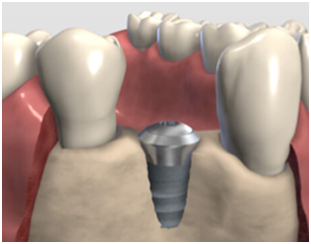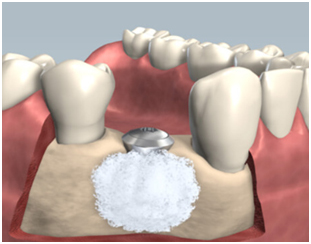As a result of tooth extraction, dental infection, trauma and post-operative bone resorption, it would be necessary to reconstruct or augment the bony ridge defect before or simultaneous to implant placement to ensure sufficient bone around the implant.
The alveolar ridge may need to be restored to assure a long-lasting and stable tooth replacement utilising dental implants.
The function and the aesthetics of the implant-supported teeth can both be severely compromised when the supporting bone and gum is deficient. In the absence of intact bone, it is impossible to replace a lost tooth using an implant-supported crown option.
For minor bone deficiencies, guided bone regeneration may be implemented by Dentist in London Specialists Dentists. This may involve using a membrane that acts as a biological barrier to promote bone regeneration and mineralisation around the defective alveolar ridge. The barrier prevents other cells from growing into the defect whereby enables merely the bone cells in growth.
Guided bone regeneration or ‘augmentation’ procedure is performed by Dentist in London Dentists Specialists using various techniques and materials, including human/animal-derived and synthetic products. Based on the amount of bone required, the patient’s bone or a mixture of all these may be used.
Bone regeneration and augmentation materials
Bovine-derived natural bone mineral bone with similar micro-architecture as human bone with bone scaffolding or osseo-conductive properties promoting the ingrowth of the blood vessels and bone cells which gradually integrate into the native bone completely.
Bone ceramic particulates, e.g. Cerabone® or Regen®, are synthetic bone graft materials made from tri-calcium phosphate naturally present in your bone. At the same time, it has a faster resorption profile of three to six months.
The membrane protects the bone graft particulates while preventing displacement and early resorption of the graft material. Most of the collagen membranes resorb entirely by the body following bone regeneration.
Autogenous bone grafts can be harvested from the upper of lower arches, such as the wisdom tooth area, the chin. If you do not wish to have any animal-derived graft or membrane products, please inform your doctor before signing the consent forms.
Bone regeneration and augmentation procedures
In the absence of bone augmentation, the bone defects resulting from trauma or extracted tooth, gum recession may be developed around the neck of the implant, which would result in the aesthetic and biological complication,especially in the aesthetic zone. Although bone grafting procedure is often very successful, some biological complications such as infection or resorption may interfere with successful graft integration and consolidation.

Exposed implant due to the localised bone resorption.

Bone regenerative procedure using bone graft material.
Our experienced surgeons in Dentist in London Specialists Dentists apply the most scientifically approved material and techniques in the field of Bone Regeneration thorough out the surgical procedures hence to improve the long-term biological success.
For more information and explanation, please ask one of surgeons at the time implant consultation.

